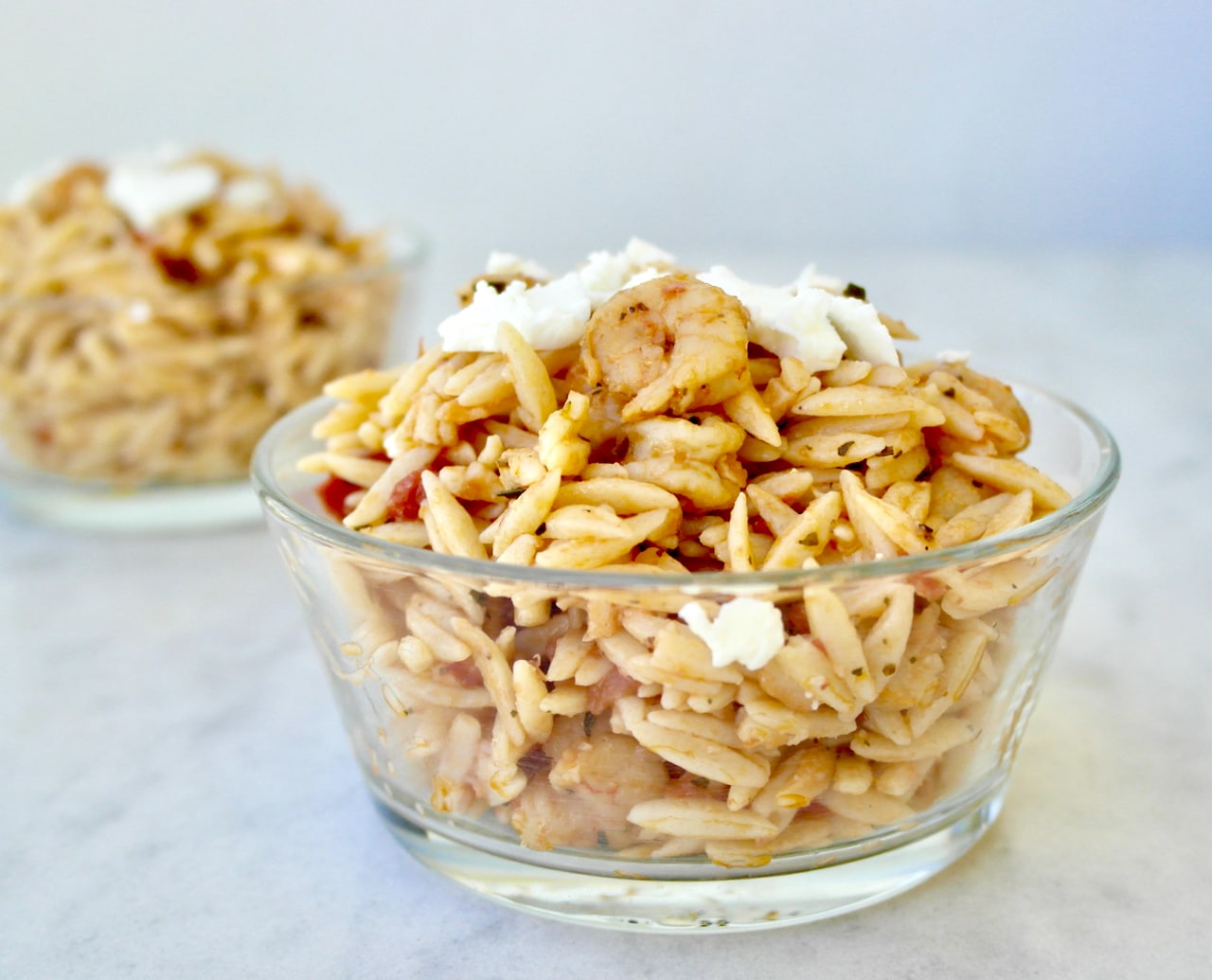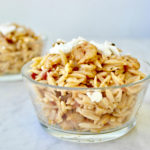Greek Orzo (kritharaki) with Shrimp and Feta

Comfort food almost everywhere usually involves some sort of pasta. Orzo known as kritharaki or manestra in Greek is usually cooked and consumed together with some sort of meat or protein making the classic dish yiouvetsi (go here for a simple version), and often served for Sunday lunch.
For this recipe I did not cook some big piece of meat, and I did not even need to use the oven. Having been under the weather for a few days I was looking for a meal that was easy to make, hearty and comforting.
I had the shrimp on hand and along with feta, they are a classic combination in Greek cuisine. Using orzo instead pasta or rice gave it a slightly different taste. And while this dish looks fairly fancy it has a really simple preparation.
This dish is fairly low in fat, the shrimp are a source of low-fat protein. And while the shrimp are a source of cholesterol, you are not eating that much of them, and it is important to know that your cholesterol will not go up just because you may eat something with cholesterol in it. Our cholesterol levels are dependent on a variety of factors including weight, smoking, genetics and of course the food we eat and do not eat. Some foods may raise cholesterol, such as those with saturated and trans fats and some foods lower cholesterol such as monounsaturated fats (the ones in olive oil), fruit, vegetables, oats and barley.
This dish can make a great main course, but you can also serve it as a first course.
Greek Orzo with Shrimp and Feta

Ingredients
- 1 pound shrimp peeled if you use frozen, defrost the night before
- ¼ cup olive oil
- 1 large minced garlic clove
- 1 shot ouzo
- 1-2 chopped tomatoes or about 6-8 ounces canned chopped tomatoes
- 1 tablespoon chopped basil
- 1 tablespoon chopped parsley
- ½ pound uncooked orzo
- 2-3 ounces crumbled feta cheese.
- Salt/pepper
Instructions
- In a pot boil the shrimp for about 4 minutes in plenty of water. Remove from water and save at least 2 cups of water
- In another deep pan or pot heat the olive oil and sauté the garlic until fragrant about 1 minute. Add the shrimp and sauté for about 2 more minutes.
- Add the shot of ouzo and sauté for another 2-3 minutes.
- Add the tomatoes, and let it come to a boil.
- Now add the 2 cups of the water from the shrimp, the orzo, ½ teaspoon of salt, pepper, the parsley and basil.
- Let it simmer until the orzo has absorbed all the water (about 10 minutes) and is soft like a risotto. Check often and add more water as needed.
- Serve with crumbled feta on top or you can mix the feta in the whole dish.

Hello Elena!
Made this Recipe, as a Super Bowl dish this past Sunday. Was almost better than the game. Posted a picture to my friends and enjoyed it solo! I immediately went to Amazon and purchased two copies of your book, one an ebook for me and another a soft back book for a friend. I was hesitant to give it to her because she is a wonderful cook herself of Mediterranean food, and the title included the words …for beginners..which she is not! The next day, Valentines Day, after much thought I gave it to her, she absolutely loved it. She’s married so I didn’t score anything but the happiness that giving brings. Thanks!
can you post or advise me some recipes that will lower cholesterol. I love to eat and I love your recipes. I’m 74 and in dire straits. Many thanks. oh yes, I live in Greece.
I made this for dinner. I used fresh tomatoes from a friends yard and fresh basil from my yard. The only alcohol I had in the house was vodka, so I tried it. Does that make it Russian orzo? Anyway, it was yummy.
Wonderful! Glad you enjoyed it!
Why do you boil the shrimp before sautéing?
Thank you!
What can I use in place of the ouzo
Hi Shelley, You can use a bit of white wine.
Hi Elena,
Made this recipe tonight and loved it! So simple, but tasty 😉 I had never cooked kritharaki before, but they’re definitely a keeper. I made a few minor changes though – I only used 1/4 teaspoon of salt, which was plenty, and I used fresh tomatoes that I peeled before adding them to the pot.
Elena,
Just out of curiosity. I know traditional Greek, or Mediterranean in general, diets are rather healthy. In terms of oil, including olive oil and cheese, “in moderation” is the mantra, despite both being a major food source.
So when I saw this, http://www.statisticbrain.com/cheese-statistics/, saying Greeks have the highest cheese consumption per capita in the world, I can’t help but wanted to know more. Greeks eat twice as much cheese as the people in the United States. True we eat a lot more other junk foods to make up whatever we miss. But the difference is significant.
This does not seem to alter the image of Greek diets being healthy, or even in any way make the Greek people less healthy. Why is that?
Is this cheese consumption a recent phenomenon (like since the 20th century, in 1900)? or it has been the tradition for much longer? How can the Greeks stay healthy with so much cheese consumption?
Hi George,
Yes, we have a high cheese consumption, and that is mainly due to feta consumption (as I’ve noted here). Most meals in the traditional Greek diet tend to be vegetarian: vegetables cooked with tomato, olive oil and herbs (lathera). So a bowl of vegetables would be considered a whole meal, and these vegetables would be accompanied by some cheese (feta usually) and some bread. So overall, since this meal is mainly vegetables, the calorie content is low with most of the fat still coming from the olive oil.